These healthy and delicious smoothie recipes for weight loss are a great way to cool down and pack in nutrients. So give these five under-300-calorie concoctions a whirl, and sip your way to a slimmer body.
A Penn State study found that people whose smoothies were blended for five minutes ate 12 percent less food afterwards and felt fuller than those whose smoothies were minimally blended. Now that’s a great weight loss tactic we can so get behind!
READ MORE: The “Amazing Skin” Smoothie Recipe That Actually Works
5 Low Calorie Smoothie Recipes For Weight Loss
1. The Cherry Bomb Smoothie
This low-calorie cherry smoothie is made with frozen cherries, kiwi, orange juice, coconut water and honey.
Simple Cherry Smoothie Recipe
This low calorie cherry smoothie is made with frozen cherries, kiwi, orange juice, coconut water and honey.Serves 1. Per serving: 665kJ, 1g fat (1g sat), 38g carbs, 129mg sodium, 5g fibre, 3g protein.
Prep Time 5 minutes mins
Course Breakfast, Drinks, SnackCuisine Healthy, Vegetarian
Servings 1 personCalories 159 kcal
¾ Cup Frozen cherries1 Kiwi, peeled and quartered¼ Cup Orange juice½ Cup Coconut water¾ tsp Honey3 Ice cubes
Up the ante: Add a scoop of vanilla protein powder for an additional 15 to 25g of protein.
Keyword breakfast, healthy, Smoothie
2. Apple Mojito Light Smoothie
With only 107 calories, this apple smoothie is great as a breakfast, snack or cocktail. That’s because it’s made with apple juice, peach, cucumber, sparkling water, lime juice, mint and honey. So delicious!
Apple Smoothie Recipe For Weight Loss
With only 107 calories, this apple smoothie is great as a breakfast, snack or cocktail. It’s made with apple juice, peach, cucumber, sparkling water, lime juice, mint and honey. Delicious!Serves 1. Per serving: 450kJ, 1g fat (1g sat), 27g carbs, 3mg sodium, 3g fibre, 2g protein.
Course Breakfast, DrinksCuisine Healthy
Servings 1 personCalories 107 kcal
¼ Cup Unsweetened apple juice1 Medium peach, peeled, pitted and quartered¼ Medium cucumber, peeled, seeded and quartered⅓ Cup Sparkling water¾ tsp Fresh lime juice3 leaves Fresh mint¾ tsp Honey6 Ice cubes
Up the ante: Add two tablespoons light rum (about 270kJ) and have it at happy hour.
Keyword breakfast, healthy, Smoothie, vegetarian
READ MORE: This Delicious DIY Tropical Coconut Granola Will Be Your New Breakfast Staple
3. Island Refresher Smoothie
This 221 calorie smoothie for weight loss is made from pineapple, mango, soy milk, cottage cheese and coconut flakes. Just trust us on this one; it’s so creamy, filling and delicious!
Pineapple Weight Loss Smoothie
This 221 calorie smoothie for weight loss is made from pineapple, mango, soy milk, cottage cheese and coconut flakes. Trust us on this one; it’s creamy, filling and delicious!Serves 1. Per serving: 925kJ, 2g fat (1g sat), 38g carbs, 244mg sodium, 4g fibre, 11g protein.
Prep Time 5 minutes mins
Course Breakfast, DrinksCuisine Healthy
Servings 1 personCalories 221 kcal
¾ Cup Pineapple, cubed½ Cup Frozen mango¾ Cup Soya milk (with a drop of vanilla essence)3 Tbsp Low-fat cottage cheese¼ tsp Unsweetened coconut flakes, for garnish
Up the ante: Add one tablespoon ground flaxseed for an extra two grams of fibre.
Keyword breakfast, healthy, Smoothie
4. Rise And Shine Smoothie
Still looking for more smoothie recipes for weight loss? Then try this delicious and filling smoothie made with avocado, sweet potato, banana, milk and honey.
Easiest Avocado Smoothie For Weight Loss
Try this delicious and filling smoothie made with avocado, sweet potato, banana, milk and honey. Serves 1. Per serving: 1 215kJ, 8g fat (1g sat), 50g carbs, 135mg sodium, 7g fibre, 9g protein
Course Breakfast, DrinksCuisine Healthy
Servings 1 personCalories 291 kcal
¼ Avocado, peeled, pitted and cubed2 Tbsp Cooked sweet potato1 Small frozen banana, sliced¾ Cup Low-fat milk½ tsp Honey
Up the ante: Blend in 1/4 cup raw or cooked oats for a thicker texture and more energy-fuelling carbs.
Keyword breakfast, healthy, Smoothie
READ MORE: The 12 Best Healthy Green Juice Recipes You Can Make With A Blender Or Juicer.
5. Awesome Almond Smoothie
Start your morning with a super satiating 233 calorie smoothie made from banana, kale, almond butter, cinnamon, nutmeg and ground ginger. So yum!
Awesome Banana, Almond & Kale Smoothie
Start your morning with a super satiating 233 calorie smoothie made from banana, kale, almond butter, cinnamon, nutmeg and ground ginger. Yum!Serves 1. 975kJ, 8g fat ( More


